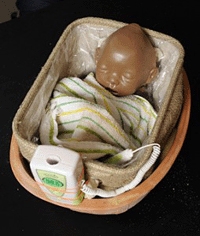When babies are deprived of oxygen before birth, brain damage and disorders such as cerebral palsy can occur.
Extended cooling can prevent brain injuries, but this treatment is not always available in developing nations where advanced medical care is scarce.

To address this need, Johns Hopkins undergraduates have devised a low-tech $40 unit to provide protective cooling in the absence of modern hospital equipment that can cost $12,000.
Dubbed Cooling Cure, the device aims to lower a newborn’s temperature by about 6oF for three days, a treatment that has been shown to protect the child from brain damage if administered shortly after a loss of oxygen has occurred.
Common causes of this deficiency are knotting of the umbilical cord or a problem with the mother’s placenta during a difficult birth. In developing regions, untrained delivery, anaemia and malnutrition during pregnancy can also contribute to oxygen deprivation.
In a recent issue of the journal Medical Devices: Evidence and Research, the biomedical engineering student inventors and their medical advisors reported successful animal testing of the Cooling Cure prototype.
The device consists a clay pot and a plastic-lined basket, separated by a layer of sand and urea-based powder. This powder is the type used in instant cold-packs that help reduce swelling. To activate the baby-cooling unit, water is added to the mixture of sand and powder, causing a chemical reaction that draws heat away from the upper basket, which cradles the child.
The unit’s AAA batteries power a microprocessor and sensors that track the child’s internal and skin temperatures. Small lights flash red if the baby’s temperature is too hot, green if the temperature is correct and blue if the child is too cold.
By viewing the lights, the baby’s nurse or a family member could add water to the sand to increase cooling. If the child is too cool, the caregiver could lift the child away from the chilling surface until the proper temperature is restored.
In recent months, three of the Cooling Cure’s student inventors—John J. Kim, Nathan Buchbinder and Simon Ammanual—have moved the project forward through animal testing and improvements to the prototype.
Working with the Johns Hopkins Technology Transfer staff, the students and their faculty advisors have obtained a provisional patent covering the low-cost baby-cooling unit.
In the near future, the student inventors hope to link up with an international medical aid group and begin human clinical trials in a developing region.
Cost-effective therapeutic hypothermia treatment device for hypoxic ischemic encephalopathy can be read here.





Glasgow trial explores AR cues for autonomous road safety
They've ploughed into a few vulnerable road users in the past. Making that less likely will make it spectacularly easy to stop the traffic for...